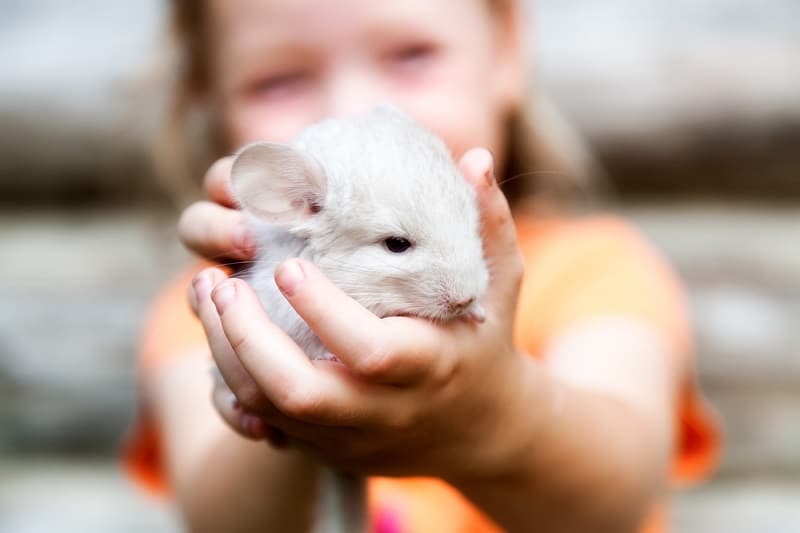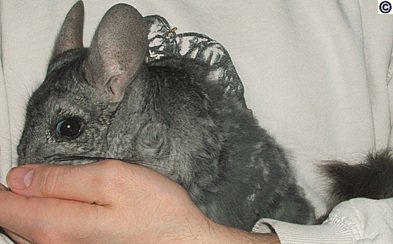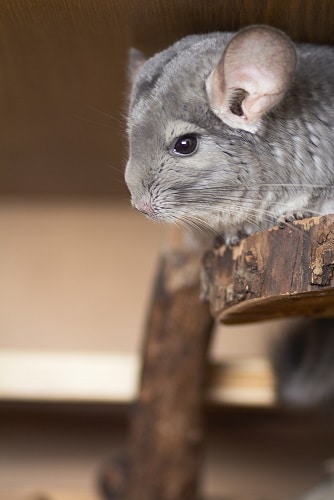
Compatibility With Other Animals
“Clients who should not own chinchillas generally include those with very noisy households, children, and/or dogs and cats. Chinchillas need quiet during the day for resting, and most do not prefer the company of dogs and cats… Chinchillas may be stressed (or injured) by the jerky movements and rough handling of children, and children may be frustrated by a chinchilla’s disinterest in being cuddled.” (ref- New Hope Animal Hospital)
Generally speaking, it is inadvisable to put your chinchilla, which is a small animal of prey, in a household with predatory animals (dogs, cats, large snakes, lizards, etc.). In the wild, chinchillas are hunted by birds (owls) and foxes. While some chins can adjust to the presence of other household pets and some may even form a strong bond with them, others will develop health and behavioral problems related to this potential environmental stress factor.
A predatory animal may mean well but can accidentally injure the chinchilla during play ( e.g., by picking up the chin by the scruff of his neck) and another small animal such as a guinea pig, degu, rat, or hamster could be accidentally hurt by the chin. The photo below shows one senior rescue chin with severe fur biting that resulted from the long term stress of coping with other household pets. For the first couple of months after arriving at the rescue, he spent his entire out-of-cage exercise time racing between and hiding beneath the furniture. There is also the potential for cross-species infectious diseases such as Pasteurella, Listeriosis, and VHD.

Chinchillas are chiefly nocturnal (but can be crepuscular, i.e., active at twilight in morning and evening) and most domestic pets are diurnal (awake during the day), this conflicts with the chinchilla’s daytime needs (some quiet solitude) for obtaining adequate rest. Having other household pets visit them during their waking hours can be disturbing or intimidating. Even if your chin does get along well with other household pets, he still needs daytime seclusion away from them to completely relax and sleep.
Whether or not a chin gets along with another species really depends a lot on the temperament and instinct of the other animal and whether it regards the chinchilla as prey, a playful toy, a potential threat, or whether it can be gentle and respectful of the chin and its need to feel safe and unmolested (and vice versa regarding the chin’s attitude). If both the chin and the other pet have shown some mutual interest in each other while the chin is INSIDE his cage, where he can move to safety and neither animal appears to be frightened, stressed, or antagonized by the other, then it’s possible they may be able to meet. When your chinchilla interacts with any other species it is necessary to CONTINUALLY supervise their interaction no matter how well acquainted or for how long they’ve known each other, because animals aren’t entirely predictable, and unexpected tragedies can result in serious injury or death.
Chins and Buns Don’t Mix
WARNING:
Rabbits can harbor Rabbit Viral Hemorrhagic Disease (VHD) and they carry Pasteurella naturally- both of these are extremely dangerous to chinchillas and most often lethal. Chins and buns need to be housed separately so that they aren’t exposed to each other’s secretions/ fecal droppings, they must have separate playtimes!
From Rabbitwise, Memphis, On Petfinder in response to an email question that we forwarded:
“I would never put an adult rabbit together with a baby chin. Instead, I’d strongly recommend that you get your male rabbit neutered and find a spayed female rabbit to keep him company. (Spaying is critical because of the high incidence of uterine cancer in unspayed females.) Although once in a while you’ll run across a rabbit that prefers to be solitary, most do much better in pairs. It’s also best to let your rabbit choose his own mate, rather than try to force friendship on two rabbits that really aren’t keen on it. Rabbits do “fall in love” and they do bond for life. If you are interested in a second rabbit and would like to let me know your city, I can check my rabbit rescue network and let you know who can help you locally.
“Rabbits do tend to carry more pathogens than chinchillas. They are bred for meat and for fur and in pet mills and are kept in horrendous conditions that do not contribute to good health. I have both chinchillas and rabbits. They have a play area in common, though they don’t play at the same time. The rabbits aren’t bothered by the chinchillas, but the chins don’t like the rabbits near their cages, even though the cages are up on legs and the rabbits can’t get near the chins. Each species is quite capable of attacking the other, and while the odds are with the rabbit, the chin can easily start a fight that ends with itself being badly hurt or killed, or the rabbit being blinded or otherwise injured.”
As Classroom Pets -and- Are Chinchillas A Good Pet For Children?
Out of consideration for both the chinchilla’s welfare and the expectations of the school children, chins should NOT be kept as pets in any (elementary, junior high, or high school) school classroom. Chinchillas are chiefly nocturnal (but can be crepuscular, i.e., active at twilight in morning and evening) while schools operate during the daytime when the chinchilla needs a setup that is relatively quiet and secure (away from prying pets, excessive traffic) to obtain adequate rest. Being kept awake during their sleeping hours by bright lights and noise day after day is nerve-shattering and can lead to stress-related problems like fur biting or anti-social (biting, urine-spraying) behavior. Every instance of a classroom chinchilla that we’ve personally seen or heard of through our rescue work has been one frightened, stressed, or unsocial animal as a result of their experience.
Chinchillas require a LARGE cage and supervised out-of-cage exercise and attention every evening. If the chin is kept in the classroom, neither classroom space nor the daytime school schedule will make it possible to meet those needs. Chinchillas also cannot tolerate high heat and humidity, the temperature is not always reliably controlled in schools, and should an emergency occur, like the air conditioning going out, it would be difficult for the teacher to just leave and rush the chinchilla to safety.
Besides the chinchilla’s health and welfare, one must consider the expectations that children have for a pet; this is especially true when a parent is considering a chinchilla as a pet for their child. Despite what appearances commonly lead people to assume, most chinchillas are not sedentary lap pets who appreciate or will sit still for a lot of handling and petting, especially if the child is unintentionally awkward or boisterous. Chinchillas are independent animals that prefer to be on the move on their terms, they can be high-strung and tend to be hyperactive, especially when young. They must be handled gently and interacted with carefully, they’re small and easy to accidentally hurt, which can happen by squeezing their ribcage, stepping or sitting on them, etc., and vet care for exotics is expensive. The “stuffed animal” treatment is stressful for a chinchilla (it can lead to health and behavioral problems) and his unwillingness to comply can make a child disappointed and disinterested in their pet altogether.
With their nocturnal schedule and need for supervised out-of-cage exercise and attention every evening, this type of regular dedication means that chins are usually too demanding for a child’s patience or interest. Rescue services frequently take in chinchillas that are relinquished due to failed expectations (the non-cuddly factor, too time-consuming), or who are no longer wanted once the child gets older and prefers to spend time with friends or pursuing other interests such as sports or extracurricular activities. Eventually, the child will be of age to leave home and go off to college, the military, or to start a family and a chinchilla is a long-term commitment, they live 10-15 years on average but can live longer.
A teacher or parent who is considering a chinchilla for a classroom or at-home pet should take these warnings into consideration.
Pets For Kids
Selections from “When the Kids Beg, ‘Can We Keep Him?'” by Tracy Vogel
When your child wants a pet, the first thing you need to think about is whether you want a pet. “It’s vitally important that the parents realize that they’re not just getting this pet for the kids,” said Nancy Peterson, companion animals specialist for the Humane Society of the United States.” The child will lose interest, hit puberty, go off to college. The adult should want to have this pet.”
In fact, it’s pretty naive to expect the child will be the pet’s first source for care, said Dr. Julie Dinnage, director of shelter animal health for the Massachusetts Society for the Prevention of Cruelty to Animals. “It’s not like the child wants a bike,” she said. “I’ve had parent clients express some level of disgust— ‘They promised me they were going to take care of it but they didn’t,'” she said. “And I look at the parent and go, well, who wasn’t being realistic here.”
When a parent is confronted by a request for a pet, another important question is the child’s motivation. Parents should have a talk with the child about the desire for a pet, said Dr. Alan Entin, a clinical psychologist and past president of the division of family psychology for the American Psychological Association. After all, your daughter could just want a dog to be like her new best friend, who has a German shepherd. Ask the children questions such as what kind of pet they want, where they got the idea, how long they’ve had the idea, and what the reasons are for choosing the pet they want, Dr. Entin said.
Once parents have an understanding of the child’s motivation, they need to think about their own reasons for getting a pet. Is it companionship for the child? To teach the child responsibility? To allow the child to feel the bond between humans and animals? The best reason is wanting to give an animal a good home, Dr. Dinnage said. But usually, the decision is based on a combination of factors. Responsibility comes up a lot. “That’s great, but at some point, the child is going to be learning by the example of the parent, not because the child is forced to do all the work,” she said.
When 18-year-old Sally Mumper brought home a Jack Russell terrier, Spot, her family ended up taking care of it. Ms. Mumper had to move out of state—and although she wants Spot, she can’t keep him where she’s staying. But Jim and Linda Mumper didn’t adopt all the responsibility. “We made her responsible for all the bills,” Linda Mumper said. “She was pretty shocked at how much a vet bill is. It’s a lot more than thinking they’re cute. You’ve got to take care of them.” Their son, Jimmy, 12, is responsible for the dog as well. “I have to walk him sometimes when I don’t want to,” he said. “I’ll be watching TV and they’ll say, ‘Go walk Spot.’” His mother smiled at him. “It’s not as great as it’s cracked up to be, is it?” she asked. He shook his head. “Uh-uh.” Then he added, “But we’re getting attached to it.”
Once you decide the family should have a pet, it’s time to decide which pet to get. You need to make that decision the way you would make any major decision—examine your lifestyle, and decide what kind of animal best fits into it. First, consider the age of the child—most recommend that you not bring a pet into a household with a child younger than three or four. A child won’t understand that the pet is more than a toy, that it experiences pain. So pulling on the cat’s tail and grabbing at the dog is going to be common. “A child should be out of diapers before you get a dog,” said Dr. Lawrence Gerson, president of the Pennsylvania Veterinary Medical Association.
Some of the smaller animals are also nocturnal—so that might not be much fun for a child that wants to see the pet scampering around during the day. Keep in mind that a small animal, while fairly inexpensive, will end up costing you more in the long run. “If the hamster gets sick, you’re going to end up paying a lot more for this pet,” Ms. Peterson said. “You wouldn’t be sending such a good message to the child – ‘This pet costs $7, we’ll just replace him. That’s not teaching responsibility, to teach that these animals are disposable.”
Think about the amount of exercise the animal will need, your ability to find a pet-sitter or kennel for it when you go on vacation, shedding problems, and training. Of course, pets also have benefits. They give unconditional love, which could raise a child’s self-esteem—although that’s just speculation, Dr. Entin said. They teach a sense of sharing—the pet belongs to everyone—and responsibility. “They realize they’re not the only ones whose needs have to be met,” he said.
Pets also come with an inherent drawback, no matter what the type. Eventually, they die. A dog or cat may last up to 15 years, a small pet perhaps just a few. But that can be a valuable lesson, Dr. Entin said. “It’s important to teach kids about life, and loss, and death, and all that, so I wouldn’t be against it for that reason.” And in the time in between, it gives the child a playmate. But that’s something parents need to think about as well, Ms. Peterson said. “When I was young, I remember I just yearned for a dog that would be my best friend and buddy,” she recalled. “That’s a big responsibility to put on a pet.” If that is the reason the child is asking for a pet, think carefully about what’s happening, Ms. Peterson said. “A pet may fill some of that need, but parents need to look at how they themselves are filling those needs,” she said. “A pet is just icing on the cake.”

